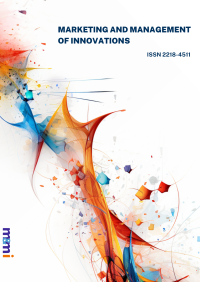| Contents |
Authors:
V.I. Gubenko,
Bila Tserkva National Agrarian University (Bila Tserkva, Ukraine)
Pages: 64-84
Language: English
DOI: https://doi.org/10.21272/mmi.2016.4-05
| Download: |
Views: |
Downloads: |
|
|
|
|
Abstract
The aim of this article. It should be analyzed foreign activities of the agro-industrial complex of Ukraine with the European Union and other regional trade groupings (RTG) in 2000-2015 and losses from insufficient competitiveness of domestic goods and should be done theoretical justification of the necessary criteria for the implementation by Ukraine as a candidate for EU membership. It was founded that in its more than half-centenary of European community it has come a long way from international organizations rather with narrow and specific areas of activity, such as coal and steel, atomic energy to broad economic cooperation and create a unique, comprehensive integration, largely governmental international combining elements of supra and universal jurisdiction − the European Union.
The results of the analysis. The European Union changed fundamentally. Its size, quality characteristics, composition, economic status and political role on the world stage, conditions and requirements for candidate countries for joining in it changed too. As an applicant for the EU membership Ukraine should be prepared for accession, meeting the criteria adopted by the European Council in 1993 in Copenhagen, as performed theoretical and methodological study areas and ways of implementation of these criteria and guidelines for the establishment of conditions for a new level of economic development country and its priority sectors, consistency of external economic relations with the EU and other RTG, expediency on the application of approaches in Ukraine “Marshall Plan”, which is necessary not only for obtaining funds to rebuild the economy, but also for successful integration in Ukraine, which will create healthy economics on the principles of transparency of the state and business revitalization efforts of the government and people to develop production, diversify and expand production and foreign trade and economic and financial stability. It is proved that for effective participation of the national economy in the European process, Ukraine needs a reference system that provides for adjustments to economic proportions that can provide a device structure of the national economy to the needs of the world and European markets and create conditions for achieving a new level of development of priority sectors in BC connection. It is proposed that, based on the theory of negative growth, developing countries, focused on expanding commodity exports negatively affect the state of their economy. But because of the instability of commodity prices and their downward trend, the conditions for agriculture of Ukraine as for developing countries, deteriorate, and therefore to increase the proportion of products deep processing, Ukraine should restrict the import goods industry, replacing them with produced goods. Therefore, for achieving synchronization process of opening the markets of the EU and Ukraine it should changed the formula of calculating the G. Trabela’s index of foreign trade to reflect real trade volumes, reflecting both quantitative and qualitative indicators of foreign economic activity. It is proved that formed on the basis of customs and tariff policy of openness of the EU and Ukraine reflects the level of economic activity, its branching and capacity, result in the development of integration processes, which gives reason to build the mechanism of opening markets of the EU and Ukraine, to bring together the level of domestic prices products of the agricultural sector, eliminate trade barriers and create a common EU rules for trade with third cranes.
It is determined that the opening of Ukraine’s domestic market to imports from EU countries is advisable to perform a mode that the level of import prices with duty exceeded the prices formed on the consumer internal market of Ukraine, but their level without fee should not exceed world market prices. Regarding the opening of the EU internal market for goods imported from Ukraine, it is justified to proceed from the fact that import prices free of duty to the level were not below world market prices. The size of the fee is determined depending on whether the price of Internal Market price exceeds the world market or not. The mechanism of opening the markets of the EU and Ukraine the best serves as interest of both countries to the EU and Ukraine. The analysis of the dynamics of foreign trade of agriculture of Ukraine with the EU and other countries of RTG in 2000-2015 and it is determined that in 2000-2014 Ukraine’s GDP increased in 4,22 times, GD of agro-industrial complex − in 1,9 times, including grain production increased in 2,6 times, sunflower seeds − in 2,92, vegetables − in 1,65, meat – 1,17, eggs − in 2,29 times. Exports in GDP of the country amounted to 42,1%, export in GD of agro-industrial complex − 79,9%, in 2015 − 80%, export of agricultural products in the structure of domestic export increased in 1,58 times and amounted to 31,5%. Ukraine’s total exports increased in 3,7 times, export of agro-industrial complex − in 10,77 times. Ukraine coverage ratio was 1,025, agro-industrial complex − 2,65 or increased in 1,67 times. Exports of agricultural products to the EU increased over 2000-2014 in 14,7 times and amounted to 29% of total export industry, imports from the EU to Ukraine increased in 10,2 times and amounted in 2014 to 42% of all imports industry ($ 2,72 billion). By share of FTT, export, import and external balance of the EU countries occupy 33%; 29%; 42%; 21%. The share of CIS countries in 2014 decreased compared to 2000 to FTT − from 38% to 14.2%, to export − 51% to 15,1%, to import − from 18% to 12%.
Conclusions and directions for further research. The analysis of export of agricultural products in Ukraine bulk and price terms, world prices and prices of agricultural products on the world and the European markets and losses in 2014 to 2012 is carried out and its founded that the total loss of Ukraine amounted to $ 6,1137, losses in the EU − $ 1,4 billions. For building a competitive economy of Ukraine, in addition to creating a “New Marshall Plan”, for implementing the proposed mechanism it is advisable to open markets of the EU and Ukraine’s agro-industrial complex that meets the interests of both countries of European Union and Ukraine. At the further studies author is planning to examine foreign relations of agro-industrial complex of Ukraine in the context of individual EU countries, the state of general relativity “Ukraine – EU’ relations with other countries and RTG scientific and methodological challenges in terms of improving that these relations were mutually beneficial.
Keywords: mechanism, opening of the markets of the EU and agro-industrial complex of Ukraine, “Marshall Plan”, integration, internationalization, tax, levels of prices
JEL Classification: F01, Q17.
Cite as: Gubenko, V. (2016). The mechanism of opening the markets of the EU and agro-industrial complex of Ukraine: trend and variations. Marketing and Management of Innovations, 4, 64-84. https://doi.org/10.21272/mmi.2016.4-05
 This work is licensed under a Creative Commons Attribution 4.0 International License This work is licensed under a Creative Commons Attribution 4.0 International License
References
- Kisterskyy, L.L. (2015). Formuvannia suchasnoi Yevropy: strymuvannia ta rozvytok [Formation of modern Europe: deterrence and development]. Ekonomika Ukrainy – Economics of Ukraine, 4, p.19-26 [in Ukrainian].
- Support Ukrainians and they can help us build a Europe. (2014). The Guardian. − London [in English].
- Soros, G.A. (2015). New Polycy to Rescue Ukraine. – The New York Review of Books. nybooks.com. Retrieved from http://www.nybooks.com/articlesarhives/2015/feb/05/new_policy_recue_ ukraine [in English].
- Deyneko, L.V., Yakubivskyy, M.N., Shovkun, I.A., Zagorodnya, M.Y., Hahovych, N.G. (2015). Kliuchovi aspekty «Planu Marshala» dlia Ukrainy u promyslovii sferi [Key aspects of “Marshall Plan” for Ukraine in the industrial sector]. Ekonomika Ukrainy – Economics of Ukraine, 4, 70-77 [in Ukrainian].
- Sharov, O.M. (2014). Vykhid z kryzy: uroky «planu Marshala» ta perspektyvy dlia Ukrainy [Out of the crisis: Lessons “Marshall Plan” and prospects for Ukraine]. Ekonomika Ukrainy – Economics of Ukraine, 12, 20-28 [in Ukrainian].
- Aslund, А. (2014). Marshall’s Postwar Logic Holds True in Ukraine. Today Financial Finance. Retrieved from: http://www.ft.com/cms/s/0/f7889a8e-594e-11e4-9546-00144feab7de.html [in English].
- Moldovan, L.V., Shubravska, A.V. (2014). Investytsiini prioritety u sferi rozvytku ahropromyslovoho vyrobnytstva Ukrainy ta mekhanizmy yikh realizatsii [Investment priorities in the field of agriculture production in Ukraine and mechanisms for their implementation]. Ekonomika Ukrainy – Economics of Ukraine, 4. 78-87 [in Ukrainian].
- Geyets, V.M. (2015). Podolannia kvazimotornosti – shliakh do investytsiino oriientovanoi ekonomiky [Overcoming of quasi motority − the path to investment-oriented economy]. Ekonomika Ukrainy – Economics of Ukraine, 6, 4-17 [in Ukrainian].
- Haber, I. (2013) Integracia Europejska: Podstawy wiedzy. Gliwice: Dom Wydawniczy AGNUS. 288 p. [in Polish].
- Hubenko, V.I. (2015). Rozvytok vyrobnytstva ta intehratsiynykh protsesiv v ahrarniy sferi v aspekti yevropeys’koyi intehratsiyi Ukrayiny [Development of production and integration processes in the agricultural sector in terms of Ukraine’s European integration]. Economichnyi forum – Economic Forum, 4, 71-80 [in Ukrainian].
- Kochetov, E. (2002). Hlobalistyka: teoriia, metodolohiia, praktyka [Global Studies: Theory, Methodology. Practice]. Moscva: NORMA-INFRA-M [in Russian].
- Sokolov, V. (2004). Heoekonomycheskii vzhliad na problemy hlobalistiki [Geo-economic perspective on the problem of global]. EiMO – WEaIR, 4, 122 [in Russian].
- Zinchuk, T.O. (2015). Problemy adaptatsii ahrarnoho sektoru ekonomiky do umov Uhody pro zonu vilnoi torhivli Ukrainy – YeS [Problems adapting the agricultural sector to the terms of the FTA Ukraine−EU]. Economika APK – Economics of AIC. 5, 79-87 [in Ukrainian].
- Zvit pro stan zovnishnoekonomichnykh vidnosyn v systemi ahropromyslovoho kompleksu Ukrainy za 2014 r. [Report about the state of foreign economic relations in agriculture system of Ukraine in 2014] (2015). Kiev [in Ukrainian].
- Sledz, S. Ahroeksport: proshchai Rossiia – torhuem s Kitaem [Agroexport: Goodbye Russia − we trade with China]. gazeta.ZP.ua. Retrieved from: http://gazeta.zn.ua/business/agroeksport-proschay-rossiya-torguem-s-kitaem-krupneyshim-pokupatelem-ukrainskogo-prodovolstviya-stal-kitay-rossiya-v-autsayderah-_.html [in Russian].
- Hubenko, V.I. (2015) Rozvytok vyrobnytstva ta intehratsiynykh protsesiv v ahrarnii sferi v aspekti yevropeiskoi intehratsii Ukrainy [Development of production and integration processes in the agricultural sector in terms of Ukraine’s European integration]. Economichnyi forum – Economic Forum, 4, 71-80 [in Ukrainian].
- Zvity pro stan zovnishnoekonomichnykh vidnosyn v systemi ahropromyslovoho kompleksu Ukrainy za 2005-2014 rr. [Reports of the state of foreign economic relations in Ukraine agriculture system in 2005-2014] (2015). Kiev [in Ukrainian].
- Ekspres-vypusk DSSU Zovnishnotohovelnyi balans Ukrainy za sichen-zhovten 2015 r. [Espress release of SSSU about of foreign trade balance of Ukraine in January-October 2015]. № 584/0/08.26n-15 [in Ukrainian].
- Stan silskoho hospodarstva v sichni-zhovtni 2015 r. [State of Agriculture in January-October 2015]. SSSU. № 327/0/06.02ВН [in Ukrainian].
- Zvit pro stan zovnishnoekonomichnykh vidnosyn v systemi ahropromyslovoho kompleksu Ukrayiny za 2000 r. [Report on foreign economic relations in system of agriculture of Ukraine for 2000] (2000). K. [in Ukrainian].
- Yatsenko, O. (2010). Konkurentni pozytsii krain providnykh vyrobnykiv produktsii bdzhilnytstva [Competitive position of the leading producers of beekeeping]. Visnyk ZNAU – The Herald of ZhNAEU, 1, 132-140 [in Ukrainian].
- Yatsenko, O. (2011). Vplyv hlobalizatsiyi na tendentsii rozvytku vitchyznianoho rynku bdzhilnytstva [The impact of globalization on the domestic market trends of beekeeping]. Visnyk SNAU. Seriia Economika ta menedzhment. – Bulletin of Sumy National Agrarian University Series of Economics and Management, 5/1, 104-109 [in Ukrainian].
- Budkin, V. (2010). Problemy i perspektyvy spivrobitnytstva mizh Yevropeyskym Soiuzom ta Ukrainoiu [Problems and prospects of cooperation between EU and Ukraine]. Economika Ukrainy – Economy of Ukraine, 9, 82-86 [in Ukrainian].
- Rozrakhovano za danymy FAOSTAT [Calculated according by FAOSTAT]. faostat.fao.org. Retrieved from http://faostat.fao.org/gite/default.aspx [in English].
- Pahomov, Yu., Lukyanenko G., & Gubskiy, B. (1997). Natsional’ni ekonomiky v hlobal’nomu konkurentnomu seredovyshchi [The national economy in the global competitive environment]. Kyiv: Ukraina 1997. 237 p. [in Ukrainian].
- Kvasha, S. (2014). Pidpysannia Uhody pro Asotsiatsiiu mizh Ukrainoiu ta Yevropeyskym Soiuzom: vyklyky i perspektyvy [The signing of the Association Agreement between Ukraine and the European Union: Challenges and Prospects. NSC “Institute of agrarian economy”]. fem.sumdu.edu.ua. Retrieved from: http://fem.sumdu.edu.ua/Presentation.2014.Last.P [in Ukrainian].
- Bhagwati, J. (2014). The World Trade System: Trends and Challenges − The International Institute for Strategic Studies in Bahrain “Trade and Flag: The Changing Balance of Power in the Multilateral Trade System” [in English].
- Bhagwati, J. (2013). Why Growth Matters. Public Affairs [in English].
- Johnson, H. G. (1958). International Trade and Economic Growht Studies in Pure theory. Economic Review, vol. 10, issue 4, p. 374-376. [in English].
- Prebysh, R. (1992). Periferiinyi kapitalizm: est li emu alternativa [Peripheral Capitalism: is there any alternative instead]. Moscva: ILAN RAN [in Russian].
- Kvasha, S. (2014). Rehulyuvannia zovnishnoekonomichnoi diialnosti ahrarnoho sektora v umovakh formuvannia zony vilnoi torhivli «Ukrayina–YeS» [Regulation of foreign economic activity of the agricultural sector in the formation of a Free Trade “Ukraine-EU”]. Thesis. Dis. candidate Econ. Sciences 08.00.03, Kyiv [in Ukrainian].
- Demyanenko, S. (2003). Spilna ahrarna polityka YeS: Sut, tendentsii ta znachennia dlia Ukrainy [EU Common Agricultural Policy: essence, trends and value to Ukraine]. Ekonomika Ukrainy – Economy of Ukraine, 3, 80-86 [in Ukrainian].
- Gubenko, W. (2012). Ukraine–Bulgaria–European Union: Contemporary State and Perspectives. University of Economics, Varna, 2, 190-193 [in English].
|



